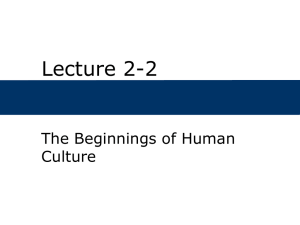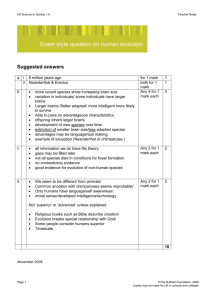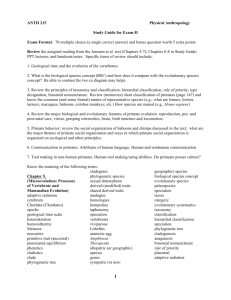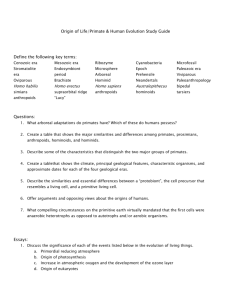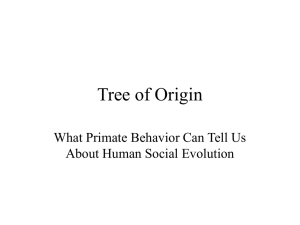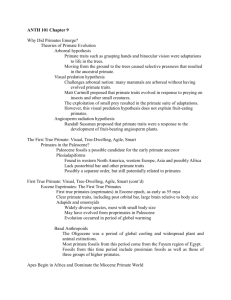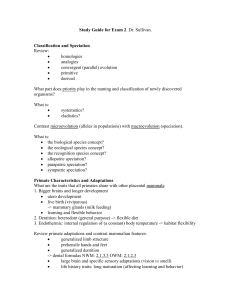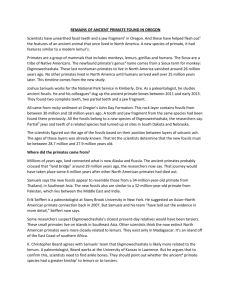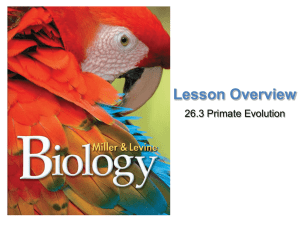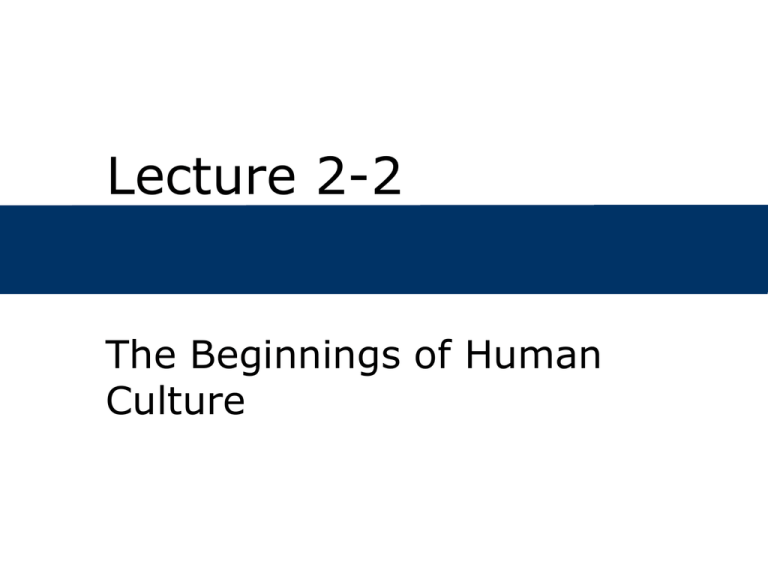
Lecture 2-2
The Beginnings of Human
Culture
Lecture Outline
To what group of animals do humans
belong?
When and how did humans evolve?
Is the biological concept of race useful
for studying physical variation in
humans?
Anthropology: Four Field
Discipline
Anthropology includes:
– Research on human cultures and languages
worldwide and through time.
– Paleoanthropologists analyze ancient fossil
humans and their ancestors.
– Primatologists study the behaviors of our
closest animal relatives and other primates.
– Others investigate the genetic basis for
variations among human populations.
Human Cultural
Adaptation
Cultural adaptations allow people to
survive in their environment:
– Manufacture and utilize tools.
– Organize social units to make
searching for food more successful.
– Preserve and share traditions and
knowledge.
Human Cultural
Adaptation
Computer technology enables us to
organize and manipulate information.
Space technology may enable us to
propagate our species in extraterrestrial
environments.
Biomedical technology may enable us to
control genetic inheritance and the
future of our biological evolution.
Humans and Other
Primates
The human species is one kind of
primate, a subgroup of mammals that
includes lemurs, monkeys, and apes.
Humans are most closely related to
apes:
– chimpanzees, gorillas, orangutans,
and gibbons
Anatomical Adaptation
Preadaptation
– Characteristics adaptive to one way of life
that also are suitable for a different way of
life.
Ancestral primates
– Preadapted to arboreal life favored by
natural selection.
Over time
– Arboreal life involves changes in various
anatomical features.
Primate Dentition
Diet available to arboreal primates
requires unspecialized teeth.
Over time, there is a trend toward
economy, with fewer smaller teeth
doing more work:
– Number of incisors decrease.
– Number of cusps on molars
increases.
Sense Organs
Decrease dependency upon sense of
smell.
Increase dependency upon sight:
– Stereoscopic color vision
– Corresponding increase in brain size
in the visual area
More acute sense of touch.
The Primate Brain
An increase in brain size, particularly in the
areas supporting conscious thought occurred
in the course of primate evolution.
In monkeys, apes, and humans the cerebral
hemispheres cover the cerebellum, the part of
the brain that coordinates muscles and
maintains balance.
Rather than relying on reflexes controlled by
the cerebellum, primates constantly react to a
variety of features in the environment.
The Primate Brain
Messages from hands and feet, eyes and ears,
and balance, movement, heat, touch, and pain
sensors are simultaneously relayed to the
cerebral cortex.
The cortex had to develop in order to receive,
analyze, and coordinate these impressions and
transmit a response back to the motor nerves.
The enlarged, responsive, cerebral cortex
provides the biological basis for flexible
behavior patterns found in all primates,
including humans.
The Primate Skeleton
Opening of the skull for the spinal cord
shifts forward toward the skull’s base
accommodating upright posture.
Snout or muzzle portion of the skull
reduced
Arms at side rather than the front part
of the body
Retention of the primate prehensile
hand with opposable thumb
Primate Skeleton
Bison skeleton (left) and Gorilla skeleton (right)
Adaptation Through
Behavior
Arboreal life involved changes in behavior as
well as in anatomical features.
Learned social behavior plays an important
role:
– Social behavior rarely observable in fossil
record
– Examination of contemporary primate
behavior may lead to clues to early primate
behavior and the emergence of human
cultural behavior
Chimpanzee Behavior
Communities with open subgroups
Males generally move
Male dominance with mother important in
determining rank
Maintain strong mother-child bond
Grooming is a common pastime
Promiscuous sex when female is fertile
Settle disputes by aggressive behavior
Dependence upon cultural behavior
Make and use tools
Males hunt in groups and share kill
Reconciliation and Its Cultural
Modification in Primates
There is evidence for reconciliation in more
than 25 different primate species.
Reconciliation is common mechanism found
whenever relationships need to be maintained
despite occasional conflict.
Chimpanzees are the only animals to use
mediators in conflict resolution.
Reconciliation is a learned social skill subject
to what primatologists now increasingly call
“culture”.
Human Ancestors
Chimpanzees and gorillas
– Closest living relatives to humans
– Humans, bonobos and chimpanzees
98.5% genetically identical
Separation from a common stock
– Genetics suggest divergence at least
5.5 million years ago
– Fossil evidence shows separation at
least 4.4 mya
Human Ancestors
Ancestors of humans
– Most likely apelike animals
– Living in Africa
– Forced by climactic changes to leave
trees
Monkeys, Apes, and
Humans
Molecular evidence indicates the split between
the human and African ape lines took place
between 8 and 5 million years ago.
The First Hominines:
Australopithecus
Earliest well-known hominine, who lived
between 1 and 4.2, if not 5.6 m.y.a. and which
includes several species.
– Found in eastern Africa and westward into
Chad
– Fully bipedal
– Brain appears apelike
– Teeth more like modern humans than apes
– Males about twice the size of females
– Likely depended upon animal flesh in diet
Homo habilis
Earliest species of the genus Homo
Increased consumption of meat
– Living primarily on the savannah
– Scavenging from carcasses
– Dentition not suited for meat eating,
so they probably needed tools to
butcher carcasses.
– Increased brain complexity and size
Homo habilis
Culture
– Using wits to compete with large
animals
– Food sharing and preparation
– Butchering sites where carcasses are
brought
Homo habilis
Invention of tools about 2.5 million
years ago
– Oldowan tools
•Striking flakes from core
– Paleolithic
•The Old Stone Age, characterized
by chipped stone tools.
Homo erectus
Species directly ancestral to modern humans
Had a body size and proportions similar to
modern humans, though with heavier
musculature.
Average brain size fell within the higher range
of H. habilis and the lower range of modern
human brain size.
Dentition was fully human, though relatively
large by modern standards.
Homo erectus
Culture
– Fire and cooking circa 700,000 years
ago
– Toolkit diversity
– New tool making techniques
– Selectivity of raw material
– Evidence of organized hunting as the
means for procuring meat, animal
hides, horn and bone.
Homo sapiens
First appear about 300,000 years ago
Archaic Homo sapiens
– Neanderthal
• Europe and Asia
• Large brained
• Massive face
– Other groups found in Java, Zambia, China
Modern Homo sapiens
• Less massive face
• Less bony architecture
Anatomically Modern Peoples
and the Upper Paleolithic
Upper Paleolithic peoples
– First people of modern appearance, who
lived in the last part of the Old Stone Age.
Culture emerges as a more potent force than
biology
Tools surpass the physical equipment of
predators
• Bow and arrow
Tool Making: Upper
Paleolithic
A technique used to manufacture blades: The stone was
broken to create a striking platform, then vertical blades
were flaked off to form sharp-edged tools.
Anatomically Modern Peoples
and the Upper Paleolithic
Art
– Decoration
– Sculpture
– Pendants
– Cave painting
Ritual
– Trance
– Burial
Race and Human
Evolution
Anthropologists agree no subspecies
exist within currently surviving Homo
sapiens.
As far as contemporary humanity is
concerned, race is not a valid biological
category.
Anthropologists work to expose the
concept of race as scientifically
inapplicable to humans.
Race as a Cultural
Construct
Although biological variation exists in the
human species, biological races or distinct
subspecies do not.
Variation such as differences in skin color is
the result of genetically adaptive processes to
different natural environments.
The majority of human variation exists within
populations rather than among populations
due to
– independent inheritance of individual traits
– genetic openness of human populations

